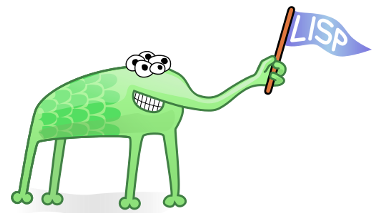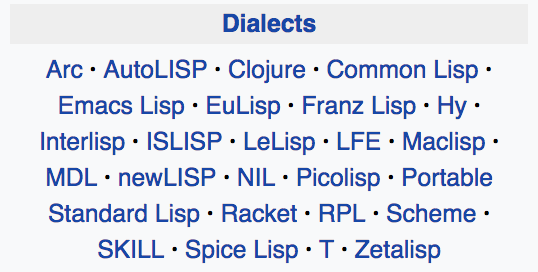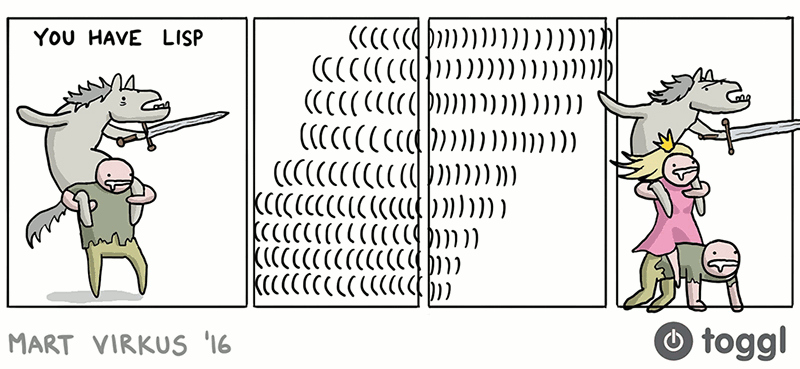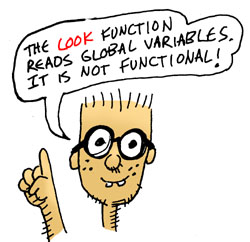class: center, middle, title-slide # Lisp Speech Therapy ### (Or: trying to explain some misconceptions about Lisp) [](https://www.runtime-revolution.com) --- class: center, middle # Bruno Jacquet --  --  --- background-size: 200% background-image: url(assets/images/lisp.png) class: middle font-size: 18px ```lisp λ "Farewell SISCOG!" "Farewell SISCOG!" λ (format t "~{~a~^, ~}." (loop for n from 10 to 15 for f = (mod n 3) for b = (mod n 5) collect (format nil "~[fizz~]~[buzz~]~[~:;~d~]" f b (* f b) n)) "buzz, 11, fizz, 13, 14, fizzbuzz." ``` --- background-color: #eb5745 background-size: 70% background-image: url(assets/images/ruby.png) class: middle ```ruby > "Hello, Runtime Revolution!" "Hello, Runtime Revolution!" > (10..15).map do |i| x = '' x += 'fizz' if i % 3 == 0 x += 'buzz' if i % 5 == 0 x.empty? ? i.to_s : x.to_s end.join(', ') + '.' "buzz, 11, fizz, 13, 14, fizzbuzz." ``` --- class: center, middle # Define Lisp --- background-color: black background-image: url(assets/images/John-McCarthy.jpg) background-size: contain ??? Hard to pinpoint when Lisp was created. 1958~1962 In 1960 John McCarthy released paper "Recursive Functions of Symbolic Expressions and Their Computation by Machine, Part I". There, he showed that with a few simple operators and a notation for functions, one can build a Turing-complete language for algorithms. Turing-complete: which can simulate a Turing machine. --- class: center, middle # Define Lisp in 2018 -- ## Lisp is not a programming language -- ## Lisp is a **family** of programming languages --  ??? Most likely when referring to 'Lisp' one is referring to 'Common Lisp'. --- class: center, middle # Define Lisp in 2018 ## Lisp is not a programming language ## Lisp is a **family** of programming languages  --- class: center, middle # _"…show me the code."_  --- # Parenthesis Everywhere ```lisp (defun birthday-paradox (probability people) (let ((new-probability (* (/ (- +year-size+ people) +year-size+) probability))) (if (< new-probability 0.5) (1+ people) (birthday-paradox new-probability (1+ people))))) ``` ```lisp λ (list 1 "b" 'c #'+) (1 "b" c +) ``` * Expression delimiters * Represent data as lists ??? Parenthesis are the only delimiters. Newcomers have a hard counting them. Old-timers follow the flow by indentation. "In my time" Lisp was taught in pen-n-paper! One had to keep track of open '(' Although important, it push the student away from the language. --- # Delimiters Ruby ```ruby def permutation(l = []) for e in 1..6 a, i = [], e-2 (0..l.length-e+1).each do |g| if not (n = l[g..g+e-2]).uniq! a.concat(n[(a[0]? i : 0)..-1]).push(e).concat(n) i = e-2 else i -= 1 end end a.each { |n| print n }; puts "\n\n" l = a end end ``` ??? def end for function block () for function arguments , to separate arguments in/do end for iteration block {} for iteration block (alternative) [] for array accessor . to call instance class function --- # Prefix Notation  ??? Devs joke that you have to put every command upfront. -- ```lisp (if (< new-probability 0.5) (setq people (+ people 1)) (birthday-paradox new-probability (1+ people)))) ``` ??? It actually looks good for if conditionals. But not so much on lesser-then. Overall, is no different from calling functions all the time. --- layout: true class: split-two with-thick-border border-white .column.bg-main1[.content[ # Prefix Notation ```lisp λ (/ (+ (- b) (sqrt (- (expt b 2) (* 4 a c)))) (* 2 a)) 42 ``` <br> ```lisp λ (+ 1 2 3 4) 10 ``` ]] .column.bg-main2[.content[ # Infix Notation ```ruby > (-b + Math.sqrt(b**2 - 4 * a * c)) / (2 * a) 42 ``` <br><br> <br> ```ruby > 1 + 2 + 3 + 4 => 10 ``` ]] --- class: show-100 ??? Simple formula look like jigsaw puzzles. --- class: show-110 count: false ??? Much more readable. But not as versatile. --- layout: false background-image: url(assets/images/recursion.jpg) background-size: 50% # Recursion ??? Some devs talk about recursion as if only some languages have it. --- # Recursion ```lisp (defun factorial (n) (factorial-aux n 1)) (defun factorial-aux (n a) (if (= n 1) a (factorial-aux (- n 1) (* n a)))) ``` ??? Recursion is not exclusive to Lisp Every language has it. --- # Recursion ```ruby def factorial(n) factorial_aux(n, 1) end def factorial-aux(n, a) n == 1 ? a : factorial_aux(n - 1, n * a) end ``` ??? Could it be that other languages aren't as optimized as Lisp for tail recursion? -- ```ruby def factorial(n) return 1 if n == 0 (1..n).inject(:*) end ``` ??? A more rubyist way of doing it. --- # Functional Programming ## Higher-order functions ## Purity ## Recursion ??? There is a hype on Functional Programming. And devs tend to associate Lisp with it. -- ### Lisp has these features and so does Ruby ### Yet neither are considered _pure_ functional ??? - functions are passed as arguments to other functions or returned as results. - functions without side effects, don't change the state. - same input return same output. - functions that call themselves. Not pure because they have mutable variables. --- # Functional Programming ```lisp (defun look () (append (describe-location *location* *map*) (describe-paths *location* *map*) (describe-floor *location* *objects* *object-locations*))) ``` -- .center[] ??? Function with side effects, increments `counter` in the background. `counter` is actually *15*. --- class: middle center # Topics Covered ## History ## Syntax ## Recursion ## Functional Programming --- class: middle center # Other Topics ## Macros ## Is slooooow ## It's only for AI ## No one else uses it ## There's no GUI in Lisp ## Doesn't have good IDE --- class: middle center # Thank you!  --- # Notes & References * _Casting Spels in Lisp_, http://www.lisperati.com/casting.html * _Features of Common Lisp_, Abhishek Reddy, http://random-state.net/features-of-common-lisp.html * _HaskellWiki_, https://wiki.haskell.org/Functional_programming * _Recursive Functions of Symbolic Expressions and Their Computation by Machine, Part I_, John McCarthy, 1960 * _Successful Lisp_, David B. Lamkins, 2004